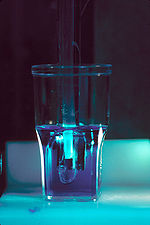
Coulter counter
Encyclopedia

is an apparatus for counting
Cell counting
Cell counting is a general name for various methods for the quantification of cells in molecular biology and in medicine.- The need for cell counting :...
and sizing particles suspended in electrolytes
Electrolyte
In chemistry, an electrolyte is any substance containing free ions that make the substance electrically conductive. The most typical electrolyte is an ionic solution, but molten electrolytes and solid electrolytes are also possible....
. It is used for cell
Cell (biology)
The cell is the basic structural and functional unit of all known living organisms. It is the smallest unit of life that is classified as a living thing, and is often called the building block of life. The Alberts text discusses how the "cellular building blocks" move to shape developing embryos....
s, bacteria
Bacteria
Bacteria are a large domain of prokaryotic microorganisms. Typically a few micrometres in length, bacteria have a wide range of shapes, ranging from spheres to rods and spirals...
, prokaryotic cells
Prokaryote
The prokaryotes are a group of organisms that lack a cell nucleus , or any other membrane-bound organelles. The organisms that have a cell nucleus are called eukaryotes. Most prokaryotes are unicellular, but a few such as myxobacteria have multicellular stages in their life cycles...
and virus
Virus
A virus is a small infectious agent that can replicate only inside the living cells of organisms. Viruses infect all types of organisms, from animals and plants to bacteria and archaea...
particles.
A typical Coulter counter has one or more microchannels that separate two chambers containing electrolyte solutions. As fluid containing particles or cells is drawn through each microchannel, each particle causes a brief change to the electrical resistance of the liquid. The counter detects these changes in electrical resistance.
Cells, being non-conducting particles, alter the effective cross-section of the conductive microchannel. If these particles are non-conducting, the electrical resistance across the channel increases, causing the electric current passing across the channel to briefly decrease. By monitoring such pulses in electric current, the number of particles for a given volume of fluid can be counted. The size of the electric current change is related to the size of the particle, enabling a particle size distribution to be measured, which can be correlated to mobility, surface charge, and concentration of the particles.
An American inventor named Wallace H. Coulter
Wallace H. Coulter
Wallace H. Coulter was an American electrical engineer, inventor, and businessman. He is best known for his discovery of the Coulter principle, which provided a methodology for counting, measuring and evaluating microscopic particles suspended in fluid...
was responsible for the theory and design of the Coulter Counter. He first devised the theory behind its operation in 1947 while experimenting with electronics. Coulter determined that electrical charge could be used to determine the size and number of microscopic particles in a solution. This phenomenon is now known as the Coulter Principle.
The Coulter Counter is a vital constituent of today's hospital laboratory. Its primary function being the quick and accurate analysis of complete blood count
Complete blood count
A complete blood count , also known as full blood count or full blood exam or blood panel, is a test panel requested by a doctor or other medical professional that gives information about the cells in a patient's blood...
s (often referred to as CBC). The CBC is used to determine the number or proportion of white and red blood cells in the body. Previously, this procedure involved preparing a blood cell stain and manually counting each type of cell under a microscope
Microscope
A microscope is an instrument used to see objects that are too small for the naked eye. The science of investigating small objects using such an instrument is called microscopy...
, a process that typically took a half hour.
Coulter Counters have a wide variety of applications including paint, ceramics, glass, molten metals and food manufacture. They are also routinely employed for quality control.
Other cell counting technologies that employ similar systems are also used, one of these being the CASY cell counting technology
CASY cell counting technology
CASY technology is an electric field multi-channel cell counting system. It was first marketed by Schärfe System GmbH in 1998. In 2006, Schärfe System was acquired by Innovatis, a company focused on cell culture analysis. CASY utilizes the techniques of electric current exclusion and pulse area...
. These systems have some differences but operate on similar principles.
Due to the simple construction of these devices and the reliable sensing method, Coulter devices have found application in a broad range of particle analyses from blood cells to polymeric beads, DNA, virus particles and even metal ions. Quantitative measurements of the size and concentration of micro and nano scale particles has been accomplished using Coulter counters with reduced microchannel size so that particles pass one by one from one chamber to the other. Because this would substantially extend measurement times, multiple microchannels are used to reduce measurement times by counting particles in parallel with one another.
Another use of the Coulter principle is found in Scanning Ion Occlusion Spectroscopy (SIOS). Here a deformable membrane with a single nano-size aperture is used in order to characterize individual nano-scale particles during their transition across driven by either pressure or an electric field.
External links
- http://web.mit.edu/invent/iow/coulter.html, October 20, 1953, Wallace H. Coulter
- "Dynamically resizable nanometre-scale apertures for molecular sensing"; Stephen J. Sowerby, Murray F. Broom, George B. Petersen; Sensors and Actuators B: Chemical Volume 123, Issue 1 (2007), pages 325-330

